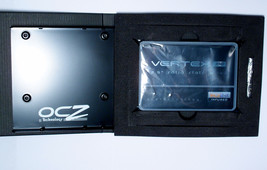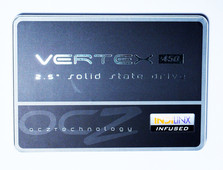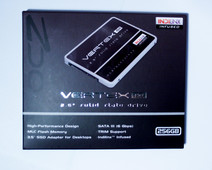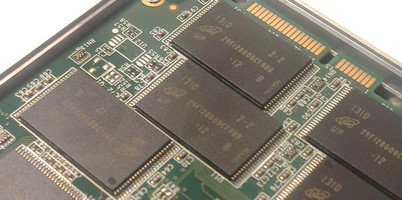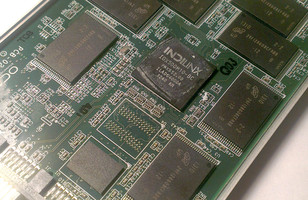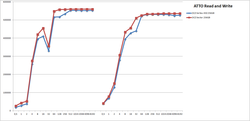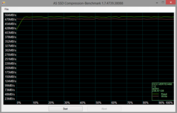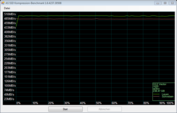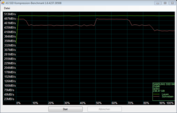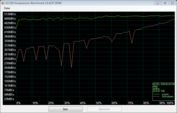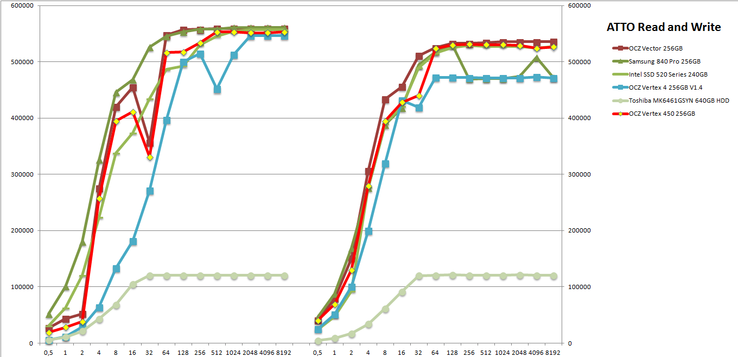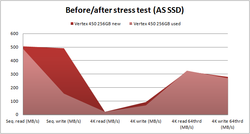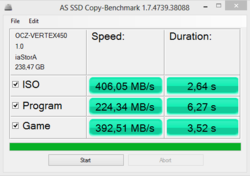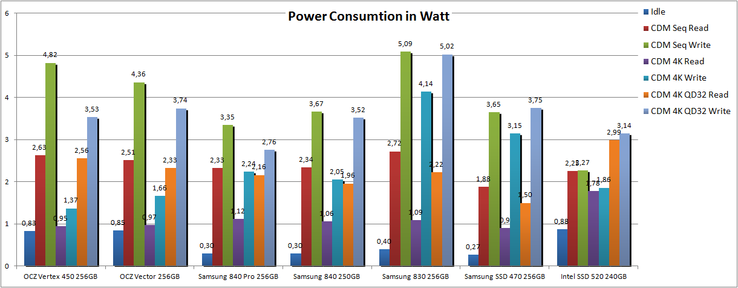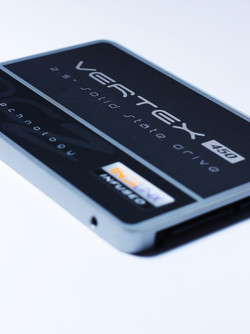Review OCZ Vertex 450 256 GB
OCZ has been around since the early days of the SSD storage industry, but in the past the company has relied on other companies such as Indilinx or SandForce to supply the all-important controller chip. In 2011, OCZ acquired Indilinx – an arrangement that after a great deal of work resulted in the present situation, where OCZ has a proprietary controller that directly competes with the ones from Samsung, Intel and LSI (SandForce).
Given that OCZ is a small player compared to the likes of Intel and Samsung, the manufacturer's ability to compete with – and sometimes surpass – these tech giants in the performance department has to be considered impressive. At least that is what OCZ accomplished with the Vector, which remains a very strong competitor to the other flagship SSDs from the leading manufacturers.
However, creating a competitive controller was not enough, there is also the matter of cost. The Vector starts to look less attractive when it's priced higher than comparable high-end drives such as the Samsung 840 Pro.
This is where the Vertex 450 comes in. This drive uses a new version of the Barefoot 3 controller from the Vector, known as the Barefoot 3 M10. Thanks to a slower clock rate (to improve factory yields) in combination with cheaper 20 nm Flash modules from Micron, instead of the 25 nm chips used in the Vector, OCZ wants to offer a more affordable drive that doesn’t sacrifice much on performance.
Inside the Vertex 450 box is the SSD, a 3.5" adapter for installing the 2.5" drive in a desktop including screws, a 7 mm to 9 mm mounting bracket for use in notebooks, an installation manual and a sticker. You also get a complimentary copy of Acronis True Image for cloning your current system drive to the Vertex 450, but only the activation key is included so you have to download it yourself. The SSD itself is encased in a nice-looking and robust aluminum enclosure, although this makes it fairly heavy (115g).
Thanks to the slightly lower clock speed compared to its predecessor, the Barefoot 3 M10 (IDX500M10-BC) uses less power at the cost of some performance, but in both cases the difference should be marginal. Another change is the move to (Micron-branded) 20 nm synchronous NAND Flash from 25 nm. Each reduction in the production process reduces the amount of PE-cycles and consequently the drive's longevity. However, this is mainly a theoretical problem as it should still last for several years of relatively heavy use.
Test System
As with other SSD reviews, we use a desktop PC, which in this case includes an Intel Core i7-3770K, a Gigabyte Z77N mainboard, 16 GB of 1600 MHz RAM and an AMD Radeon 7850 graphics card. Please note that this test setup is different from our previous SSD reviews. The SSD is installed in the first SATA 3.0 6Gbps port (port 0) and the operating system is Windows 8 Pro.
Synthetic Benchmarks
Sequential transfer rates
These days the 6 Gbps SATA interface imposes a cap on the sequential transfer speeds of modern SSDs. To go higher you have to use RAID or PCI Express. In the AS SSD benchmark, which is a versatile and useful test but has quite large error bars, our Vertex 450 comes in at 506 MB/s in the sequential read test – more or less within the margin of error compared to the other high-end drives.
Sequential write speeds are also impressive at 492 MB/s. With Crystal Disk Mark, the drive’s sequential read speeds were a bit lower at 468 MB/s and write speeds 489 MB/s. In HD Tune, the result is on par with the Vector and Vertex 4, i.e. a bit behind the competition.
In the chart on the right it is easier to visualize the Vertex 450's performance versus the Vector under (unrealistically) ideal circumstances. It's easy to see that the two drives use the same controller, with the Vertex 450 being marginally slower than its predecessor.
| CrystalDiskMark 3.0 | |
| Read Seq (sort by value) | |
| Review OCZ Vertex 450 256 GB | |
| OCZ Vector 256 GB Desktop | |
| Samsung SSD 840 Pro 256 GB Desktop | |
| Samsung SSD 840 250 GB Desktop | |
| Intel SSD 520 Series 240GB Desktop | |
| OCZ Vertex 4 256 GB Desktop | |
| Read 512 (sort by value) | |
| Review OCZ Vertex 450 256 GB | |
| OCZ Vector 256 GB Desktop | |
| Samsung SSD 840 Pro 256 GB Desktop | |
| Samsung SSD 840 250 GB Desktop | |
| Intel SSD 520 Series 240GB Desktop | |
| OCZ Vertex 4 256 GB Desktop | |
| Write Seq (sort by value) | |
| Review OCZ Vertex 450 256 GB | |
| OCZ Vector 256 GB Desktop | |
| Samsung SSD 840 Pro 256 GB Desktop | |
| Samsung SSD 840 250 GB Desktop | |
| Intel SSD 520 Series 240GB Desktop | |
| OCZ Vertex 4 256 GB Desktop | |
| Write 512 (sort by value) | |
| Review OCZ Vertex 450 256 GB | |
| OCZ Vector 256 GB Desktop | |
| Samsung SSD 840 Pro 256 GB Desktop | |
| Samsung SSD 840 250 GB Desktop | |
| Intel SSD 520 Series 240GB Desktop | |
| OCZ Vertex 4 256 GB Desktop | |
Unlike SSDs using SandForce controllers such as the SF-2281, the Barefoot 3 controller is not dependent on compressible data to reach its highest transfer rates. In fact it performs remarkably well regardless of compression, just like the Vector. It's easy to see the difference compared to the SandForce-based Intel SSD 520.
ATTO data rates
4K data rates
In terms of 4K transfer rates, the Vertex 450 falls behind the competition in some areas, but takes the lead in others. It grabs the top spot by a healthy margin in the 4K write test in AS SSD, but surprisingly does much worse in CrystalDiskMark's similar test.
| CrystalDiskMark 3.0 | |
| Read 4k (sort by value) | |
| Review OCZ Vertex 450 256 GB | |
| OCZ Vector 256 GB Desktop | |
| Samsung SSD 840 Pro 256 GB Desktop | |
| Samsung SSD 840 250 GB Desktop | |
| Intel SSD 520 Series 240GB Desktop | |
| OCZ Vertex 4 256 GB Desktop | |
| Write 4k (sort by value) | |
| Review OCZ Vertex 450 256 GB | |
| OCZ Vector 256 GB Desktop | |
| Samsung SSD 840 Pro 256 GB Desktop | |
| Samsung SSD 840 250 GB Desktop | |
| Intel SSD 520 Series 240GB Desktop | |
| OCZ Vertex 4 256 GB Desktop | |
| Read 4k QD32 (sort by value) | |
| Review OCZ Vertex 450 256 GB | |
| OCZ Vector 256 GB Desktop | |
| Samsung SSD 840 Pro 256 GB Desktop | |
| Samsung SSD 840 250 GB Desktop | |
| Intel SSD 520 Series 240GB Desktop | |
| OCZ Vertex 4 256 GB Desktop | |
| Write 4k QD32 (sort by value) | |
| Review OCZ Vertex 450 256 GB | |
| OCZ Vector 256 GB Desktop | |
| Samsung SSD 840 Pro 256 GB Desktop | |
| Samsung SSD 840 250 GB Desktop | |
| Intel SSD 520 Series 240GB Desktop | |
| OCZ Vertex 4 256 GB Desktop | |
Access times
Access times with any recent SSD are miniscule compared to mechanical hard drives. The Vertex 450 can apparently not match the Vector in read access times, but is identical when writing.
| AS SSD | |
| Access Time Read (sort by value) | |
| Review OCZ Vertex 450 256 GB | |
| OCZ Vector 256 GB Desktop | |
| Samsung SSD 840 Pro 256 GB Desktop | |
| Samsung SSD 840 250 GB Desktop | |
| Intel SSD 520 Series 240GB Desktop | |
| OCZ Vertex 4 256 GB Desktop | |
| Access Time Write (sort by value) | |
| Review OCZ Vertex 450 256 GB | |
| OCZ Vector 256 GB Desktop | |
| Samsung SSD 840 Pro 256 GB Desktop | |
| Samsung SSD 840 250 GB Desktop | |
| Intel SSD 520 Series 240GB Desktop | |
| OCZ Vertex 4 256 GB Desktop | |
* ... smaller is better
PCMark System Performance
In our PCMark results, it is important to note that the test setup has been updated from the other SSD reviews. As we now use Windows 8 Pro, which does not play well with the PC Mark Vantage, this benchmark has been omitted.
In PCMark 7, the subscore to look at is “system storage”, where the Vertex 450 places right next to the Vector and ahead of all other drives except the Samsung 840 Pro.
| PCMark 7 - System Storage (sort by value) | |
| Review OCZ Vertex 450 256 GB | |
| OCZ Vector 256 GB Desktop | |
| Samsung SSD 840 Pro 256 GB Desktop | |
| Samsung SSD 840 250 GB Desktop | |
| Intel SSD 520 Series 240GB Desktop | |
| OCZ Vertex 4 256 GB Desktop | |
Resistance to Performance Drops
Performance drops over time is problem that affects all SSDs. Modern SSD controllers handle these drops with the help of wear leveling, garbage collection and other complex processes, and they do so with varying degrees of success.
The problem is compounded as the drive starts to fill up, as there will be less spare area on which to distribute the subsequent writes and erases. Large-capacity drives or drives with much over-provisioning have an advantage here as the extra spare area reduces write amplification.
To see how well an SSD handles these issues we put the drive though a stress test using the "IOMix" profile in IOMeter. Data is written and read repeatedly to the entire drive for 60 minutes. The performance was tested before and after the torture test with AS SSD. Unlike drives with over-provisioning, the write speeds of the Vertex 450 drop significantly right after the test. 4K reads and writes are largely unaffected.
Practical Tests
During daily use, the rather boring reality is that most of the time you are unlikely to notice any difference between any of the current high-end SSDs. Windows startup is one such occasion, where all SSDs are much faster than conventional drives, but with little difference between individual models. Not counting POST, you should be able to reach the Windows 8 desktop in less than 10 seconds.
It is similarly hard to distinguish the different SSDs when starting applications and games, whereas the difference is very noticeable when comparing to an older hard drive. The Toshiba MK6461GSYN 640 GB 7200 rpm notebook hard drive needs 72 seconds to start the single-player campaign in Battlefield 3, while the same task takes 19-20 seconds with any modern SSD, and not much more than that with an older SSD.
Differences will however start to show in lengthier and more specific file copy tests. In AS SSD's built-in copy benchmark, the Vertex 450 cannot quite keep up with the Vector or the 840 Pro in the "ISO" test, but ends up surprisingly far ahead of them in the "Game" test. These results vary a great deal, but the high game copy result was repeatable.
| AS SSD | |
| Copy Game MB/s (sort by value) | |
| Review OCZ Vertex 450 256 GB | |
| OCZ Vector 256 GB Desktop | |
| Samsung SSD 840 Pro 256 GB Desktop | |
| Samsung SSD 840 250 GB Desktop | |
| Intel SSD 520 Series 240GB Desktop | |
| OCZ Vertex 4 256 GB Desktop | |
| Copy Program MB/s (sort by value) | |
| Review OCZ Vertex 450 256 GB | |
| OCZ Vector 256 GB Desktop | |
| Samsung SSD 840 Pro 256 GB Desktop | |
| Samsung SSD 840 250 GB Desktop | |
| Intel SSD 520 Series 240GB Desktop | |
| OCZ Vertex 4 256 GB Desktop | |
| Copy ISO MB/s (sort by value) | |
| Review OCZ Vertex 450 256 GB | |
| OCZ Vector 256 GB Desktop | |
| Samsung SSD 840 Pro 256 GB Desktop | |
| Samsung SSD 840 250 GB Desktop | |
| Intel SSD 520 Series 240GB Desktop | |
| OCZ Vertex 4 256 GB Desktop | |
Power Consumption
We use two multimeters to test the power consumption of SSDs under the different loads in CrystalDiskMark (current and voltage). As the tests are conducted on a desktop system, the idle values don't necessarily reflect the power consumption in notebooks with DMPI support, where drives such as the Samsung 840 Pro may drop to as little as 0.04 Watts.
Just like the Vector, the Vertex 450 uses quite a bit of power while doing nothing in particular. The value is a bit lower than the Vector, but still well above the Samsung drives. The power consumption during load is sometimes higher and sometimes lower than the Vector, but the sequential write figure stands out as considerably higher. It is, however, the best of all tested drives in 4K write power consumption.
On average, the Vertex 450 does quite well, but the power-optimized Barefoot 3 M10 does not seem to have an overly dramatic effect on power consumption in our test system.
Verdict
The Vertex 450 is a continuation of OCZ’s move towards greater independence in the manufacturing process. Thanks to its acquisition of Indilinx, the SSD specialist is now able to offer unique products that doesn’t rely on a third-party controller.
Although the Vector – the company’s first flagship product based on the in house-developed Barefoot 3 controller – was an excellent drive, it has so far had problems competing with other high-end SSDs in terms of pricing. By moving to cheaper NAND and a new revision of the Barefoot 3 with slightly lower clock speeds, OCZ is attempting to strike the perfect balance.
There’s no question that the Vertex 450 performs well enough to compete with the best drives on the market; the question that remains is whether OCZ will be able to keep the prices sufficiently low as to offer good value for the price-conscious upgrader.
It must face stiff competition from other high-end SSDs such as the Samsung SSD 840 Pro, but if this equation plays out in OCZ’s favor, the Vertex 450 could grab a well-deserved top spot in the demanding enthusiast segment.





